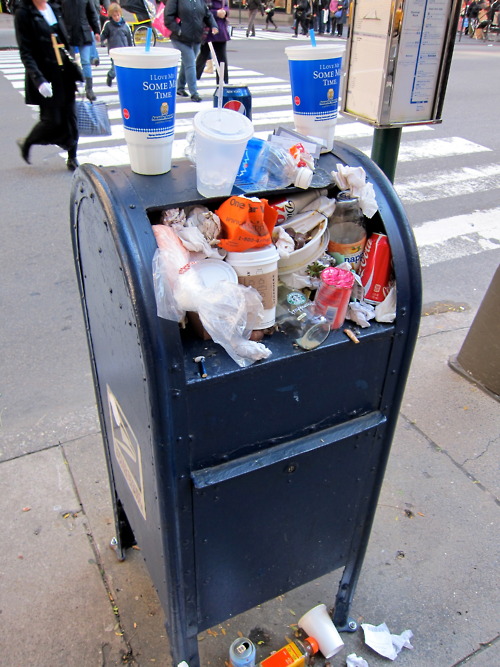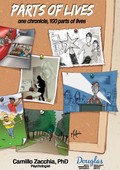A few years ago, as I was walking into a shopping center, I noticed a large sign on a door. The sign was a large green neon sign with an arrow thick enough to hide a loaf of rye bread. Underneath this
arrow, in 100+ point font, were the words: Porte Brisé (Door broken). To make matters more clear, there was a pile of chairs from floor to ceiling stacked up on the other side of the clear glass door.
Get the picture? Let me add that the day-glo green neon sign with the rye loaf-sized arrow and 100+ font words would be easily visible from the International Space Station!
Just ahead of me were two middle-aged ladies straight from a Gary Larson cartoon with purses hung off their forearms. One woman went straight for the door. She pulled and nothing happened. She pushed and nothing happened. Then she did the push-pull thing at least five more times, adding force with every attempt. Finally she gave up and turned to the other lady and said, “Je pense que la porte est brisée…Ils devront mettre un affiche.” (I think the door is broken….They should put up a sign.)
TRUE STORY!
Did I mention the sign could be seen from the International Space Station?
I don’t know who these women were or whether our meandering life lines will ever cross again but I do, in all sincerity, wish to thank them for inspiring this week’s column.
This is not a garbage can
(Source: Ceci n’est pas une poubelle. Journal Métro: December 4, 2012)
(Voir plus bas pour la version Française)I was walking to the washroom at my local Costco the other day when I passed a large wooden receptacle. It was the size of a garbage container and on the front side near the top there was a large opening. Above this opening was a sign that read, “This is not a garbage can.” I looked inside this “non-garbage can” and saw a pile of crumpled papers, tissues, and Styrofoam cups. Funny, it looked to me just like garbage.
This curious object says something about people, doesn’t it? Either the people mistaking this container for garbage are the dumb ones, or it is those that put up the sign and expected otherwise who are.
These types of occurrences are endless. We have all seen people trying to open doors directly below a sign saying, “Use other door,” speeding through photo radar zones despite large warning signs, or picking up something clearly labelled, “Do not touch!”
Being oblivious to our surroundings and acting on autopilot may seem inconsequential in these trivial cases but there are instances when this tendency can have far more serious results. People take medications that interact with others despite clear labels, and they speed around dangerous curves despite flashing yellow lights. Clearly some of us just don’t care. But there are many who do…and somehow we all keep missing signs.
There are certain things we do so often they can be done without any thought of executing the task. We drive, park, take medication, and use garbage cans so often, we become unaware of our actions. Missing a sign in these circumstances is to be expected, especially when we are surrounded by so many of them. They melt into the background.
Risk management
Risk management experts constantly struggle with this issue. Do you try to sensitize people about dangers so they will be more careful, or do you remove the source of risk altogether? This is particularly relevant to areas such as drug interactions, firearm safety, and traffic hazards. All can have serious consequences. As a result, we spend much time, effort and money to teach people about proper usage. But while sometimes this is the only option, there are many other circumstances when the dangers can be removed altogether.We could put up flashing signs asking people to slow down near a school and hope for compliance, or we can simply put in large speed bumps. We could teach firearm safety, or we can choose not to have guns. And of course we can choose to put a sign on a wooden box, or simply turn the side with the opening against the wall.
____________________________________________________________________________________
Voici la version Française:
L’autre jour, je me dirigeais vers les toilettes d’un Costco, lorsque j’ai aperçu un grand contenant de bois. De la taille d’une poubelle, il comportait à l’avant une large ouverture. Au-dessus de l’ouverture, un écriteau disait : « Ceci n’est pas une poubelle. » J’ai regardé à l’intérieur : j’y ai vu des papiers chiffonnés, des mouchoirs et des gobelets de styromousse. Moi, ça me semblait des déchets.
On se demande alors : Qui est idiot? La personne qui prend le contenant pour une poubelle, ou celle qui place l’écriteau et s’attend à ce qu’on le respecte?
Ce genre de situation se répète sans cesse. Nous avons tous vu des gens qui essaient d’ouvrir une porte sur laquelle on peut lire : « Utilisez l’autre porte », ou qui conduisent à toute vitesse dans une zone de photo radar.
Être inconscient de ce qui nous entoure et agir machinalement paraît ici sans conséquences, mais il y a des cas où cette tendance peut avoir des répercussions beaucoup plus graves. Les gens prennent des médicaments qui interagissent avec d’autres, même si l’étiquette l’indique clairement, et ils empruntent des courbes à toute allure, malgré les feux jaunes clignotants. Manifestement, certains sont négligents. Mais d’autres font attention… et tous finissent par ne pas tenir compte de certains écriteaux.
Il y a des choses qu’on fait tellement souvent, qu’on les effectue sans y penser. Nous conduisons, stationnons, prenons des médicaments et utilisons des poubelles si souvent que nous n’y réfléchissons plus. Ne pas voir un écriteau, dans ces circonstances, est naturel, surtout s’il y en a tellement qu’ils se fondent dans le décor.
Gestion du risque
Les experts en gestion du risque sont constamment aux prises avec cette question : faut-il sensibiliser les gens aux dangers pour qu’ils deviennent plus prudents, ou supprimer la source de danger? C’est particulièrement pertinent dans les domaines comme les interactions de médicaments, la sécurité liée aux armes à feu et les dangers de la circulation, qui peuvent avoir de graves conséquences. Nous consacrons donc beaucoup de temps, d’efforts et d’argent à enseigner des modes d’emploi. C’est parfois la seule solution, mais bien souvent, il est possible d’éliminer la source de danger.On pourrait placer des signaux clignotants demandant de ralentir aux abords des écoles, en espérant que les gens les respecteront, ou simplement installer des dos d’âne. On pourrait enseigner la sécurité relative aux armes à feu, ou décider de ne pas avoir de pistolets. Et, bien sûr, on peut placer un écriteau sur un grand contenant de bois, ou simplement en tourner l’ouverture face au mur.
Tagged as oblivious to surroundings, Risk management.
Posted in Human nature, Life, Random thoughts.
Posted on 07 Dec 2012

